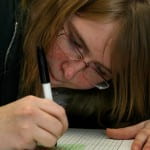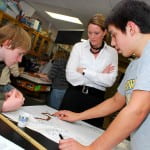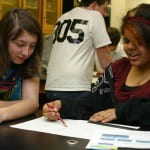Science research shows new world to students
By CAROL SPAETH-BAUER
Posted: March 12, 2009 (reprinted by permission from Living Lake Country – Journal Community Publishing Group)
Mukwonago Area School District – For the past five years, Mukwonago High School science teacher Kristin Michalski has spent six weeks of her summer in a University of Wisconsin-Milwaukee research lab studying protein interaction through the Research Experience for Teachers (RET). Last summer, she studied the fractal nature of proteins in cells. As she struggles to understand the complexity of the fractal nature of proteins in cells with UWM professor Valerica Raicu, she puts herself in the shoes of her students trying to grasp a difficult concept. Fractals are repeating geometric patterns – irregular shapes that can be subdivided, each of which is a smaller copy of the whole.
“It’s always good for you (teachers) to experience it for yourself,” said Michalski, “that feeling of fear, that feeling of stupidity.”
RET is supported by the National Science Foundation and is administered through the departments of physics, chemistry and geosciences and the Manfred Olsen Planetarium at UW-Milwaukee. The program has several goals, including to seek ways of improving the quality of teacher training and to provide enrichment, which would also improve the quality of science teaching and hopefully stimulate the interest and imaginations of students who might not otherwise study science in college.
Hoping to ignite that spark of interest in science, Michalski develops activities associated with her research to bring into her classroom, such as a recent activity to help students conceptualize the fractal nature of natural objects.
As she introduced the project recently, she pointed to the double helix in DNA as an example of a simple structure that is a repeated, or iterated, fractal design. On a more common level, Michalski used broccoli as an example of cell similarity and as an example of a fractal in nature.
Students then paired up to explore the fractal geometry of nature, using sticks and pennies as measuring tools. As students measured an irregular coastline, they discovered what happens if smaller and smaller rulers or units of measure are used. If the unit of measure is smaller, the results will be larger.
“Pennies are more accurate than sticks,” Cora Cooley noted.
When looking for examples of fractal geometry in nature, Mikayla Rozanske gave the example of veins in your hand.
In looking for more ways to make students aware of fractals, Michalski invited a number of freshman science students to take part in an after-school activity aimed at studying fractal geometry.
“Before I do any activity, I have to see what type of struggles they’re going to go through ,and also I want to see if they’re going to be able to handle it,” Michalski said. “There are a couple of fractal designs that are really hard.”
Trying to find the balance between not getting frustrated and avoiding boredom, she designed the activity to address different learning levels.
Even before Michalski offered the activity for extra credit, students were excited about being part of the learning experiment.
“When they look at those fractals, those patterns are pretty neat. It’s something they haven’t learned before, so it’s really new,” said Michalski.
Michalski finds it easy to take what she is doing at UWM in the research lab and fit it into her classroom.
“I’m always thinking about how this fits into this classroom no matter what I’m doing,” Michalski said.
The excitement students have at the elementary level gets lost in high school because there is certain content teachers are required to cover. When Michalski brings her research efforts back to MHS, it gets students excited about science again.
“It gets them thinking they can do science,” Michalski said.


